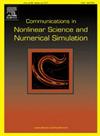Standing waves with prescribed mass for NLS equations with Hardy potential in the half-space under Neumann boundary condition
IF 3.4
2区 数学
Q1 MATHEMATICS, APPLIED
Communications in Nonlinear Science and Numerical Simulation
Pub Date : 2025-05-12
DOI:10.1016/j.cnsns.2025.108917
引用次数: 0
Abstract
Consider the Neumann problem: with the prescribed mass: where denotes the upper half-space in , is the Hardy potential, , , stands for the outward unit normal vector to , and appears as a Lagrange multiplier. Firstly, by applying Ekeland’s variational principle, we establish the existence of normalized solutions that correspond to local minima of the associated energy functional. Furthermore, we find a second normalized solution of mountain pass type by employing a parameterized minimax principle that incorporates Morse index information. Our analysis relies on a Hardy inequality in , as well as a Pohozaev identity involving the Hardy potential on . This work provides a variational framework for investigating the existence of normalized solutions to the Hardy type system within a half-space, and our approach is flexible, allowing it to be adapted to handle more general nonlinearities.
半空间中具有Hardy势的NLS方程在Neumann边界条件下的定质量驻波
考虑诺依曼问题:−Δu−μ|x|2u+λu=|u|q−2u+|u|p−2uinR+N,N≥3,∂u∂ν=0on∂R+N,规定质量:∫R+N|u|2dx=a>0,其中R+N表示RN中的上半空间,1|x|2是Hardy势,2<q<2+4N<p<2∗,μ>0, ν表示∂R+N的外单位法向量,λ以拉格朗日乘子的形式出现。首先,利用Ekeland变分原理,建立了相关能量泛函局部极小值对应的规范化解的存在性。在此基础上,利用参数化极大极小原理,结合莫尔斯指数信息,找到了山口型的第二个归一化解。我们的分析依赖于H1(R+N)中的Hardy不等式,以及R+N上涉及Hardy势的Pohozaev恒等式。这项工作为研究半空间内Hardy型系统的规范化解的存在性提供了一个变分框架,并且我们的方法是灵活的,允许它适应于处理更一般的非线性。
本文章由计算机程序翻译,如有差异,请以英文原文为准。
求助全文
约1分钟内获得全文
求助全文
来源期刊

Communications in Nonlinear Science and Numerical Simulation
MATHEMATICS, APPLIED-MATHEMATICS, INTERDISCIPLINARY APPLICATIONS
CiteScore
6.80
自引率
7.70%
发文量
378
审稿时长
78 days
期刊介绍:
The journal publishes original research findings on experimental observation, mathematical modeling, theoretical analysis and numerical simulation, for more accurate description, better prediction or novel application, of nonlinear phenomena in science and engineering. It offers a venue for researchers to make rapid exchange of ideas and techniques in nonlinear science and complexity.
The submission of manuscripts with cross-disciplinary approaches in nonlinear science and complexity is particularly encouraged.
Topics of interest:
Nonlinear differential or delay equations, Lie group analysis and asymptotic methods, Discontinuous systems, Fractals, Fractional calculus and dynamics, Nonlinear effects in quantum mechanics, Nonlinear stochastic processes, Experimental nonlinear science, Time-series and signal analysis, Computational methods and simulations in nonlinear science and engineering, Control of dynamical systems, Synchronization, Lyapunov analysis, High-dimensional chaos and turbulence, Chaos in Hamiltonian systems, Integrable systems and solitons, Collective behavior in many-body systems, Biological physics and networks, Nonlinear mechanical systems, Complex systems and complexity.
No length limitation for contributions is set, but only concisely written manuscripts are published. Brief papers are published on the basis of Rapid Communications. Discussions of previously published papers are welcome.
 求助内容:
求助内容: 应助结果提醒方式:
应助结果提醒方式:


